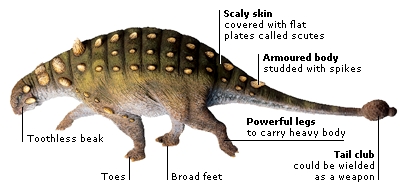DK Science: Horned & Armoured
Three major groups of plant-eating dinosaurs were well equipped to defend themselves – some of the larger ones against the fiercest of the carnivores. The plated stegosaurs were largely a Jurassic group and were armed with plates and tail spines. The horned ceratopsians lived at the end of the Cretaceous and sported a heavy neck shield and an array of horns. The armoured ankylosaurs were among the last of the dinosaurs to appear and had backs covered with armoured shields and horny plates.
All the armoured dinosaurs had ornithischian (bird-like) hips. The big plant-eating gut was carried well back like the ornithopods, but the armour usually made the animal too heavy to be bipedal. The weapons – horns, plates, tail clubs – were supported by strong muscles, which meant they could be put to good use when the animal needed to defend itself. Powerful leg muscles were needed to support the heavy body.
The heavy horned, plated, or armoured dinosaurs walked on four feet. Their hind legs were bigger than the front legs, suggesting that the dinosaurs evolved from earlier two-footed types, possibly resembling ornithopods. Like the ornithopods, they had mouths adapted for chewing, with teeth that could chop or grind. They also had beaks at the front of their mouths and cheeks at the sides. Most carried a mosaic of fine studded armour, or flat plates called scutes, on their bodies.
The ceratopsians did not have armour on their bodies. Instead, there was an armoured shield around the neck that protected the shoulders. Different types of ceratopsian had different shapes and sizes of horns that grew from the armoured heads and were used as weapons or for display. Some had a single straight or curved horn on the nose. Others had horns above the eyes. Yet others had horns arranged around their necks.
The ankylosaurs had armour embedded in the skin of their heads, necks, backs, and tails. Their armour was a fine mosaic of studs and scutes. The scutes were plate-like masses of bone covered in horn and usually had a keel (ridge) along the centre. Some were armed with shoulder-mounted spikes. Others, such as Euoplocephalus, had a club on the end of their tail. Big ankylosaurs even had armoured eyelids.
Stegosaurs had a series of flat plates and spines that stuck up in a double line along their backs. The plates may have been covered in horn, with blade-like edges and corners, and used for defence. Or they may have been covered with skin and used as heat-exchangers. Turning the plates to face the sun would have warmed the blood in them and so warmed the stegosaur. Turning them into the wind would have cooled them.
To order this book direct from the publisher, visit DK's website.



